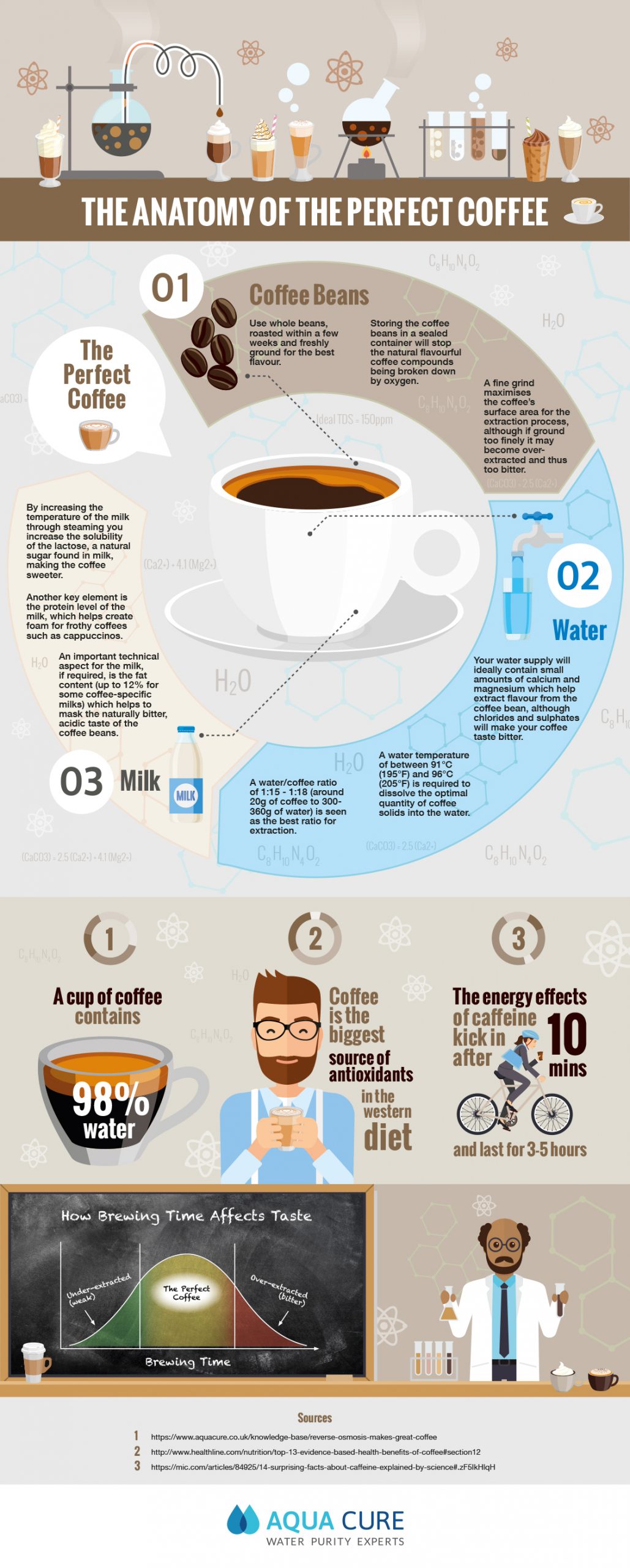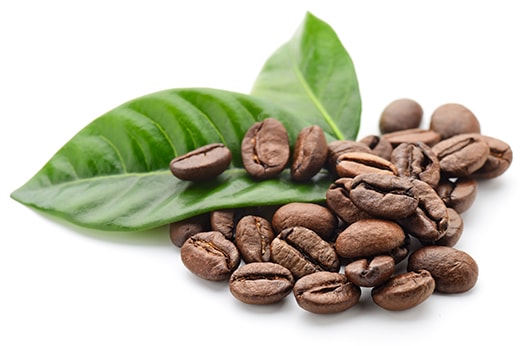Coffee making is often described as an art form but to make the perfect cuppa you also need to understand some of the science involved.
The infographic and guide below outline some of the most important scientific explanations behind coffee making - so put on your white lab coat and goggles and let's get brewing!

Embed This Infographic On Your Site
If you would like to feature this infographic on your site, please use the embed code below. Please include a link to https://www.aquacure.co.uk when you post this. The pixel width of the infographic can also be changed by altering the 'width' pixel value in the code below.
Coffee Beans

If possible use whole beans, roasted within the previous couple of weeks. The type of roast - light, medium or dark - depends on your preference. Be aware that the more the bean is roasted, the more the caffeine levels of the original coffee bean will be diminished. A dark roast tastes less acidic, but will lose some of its original sweetness and natural aroma as the inherent sugars in the coffee are caramelised in the roasting process.
Store the beans in a sealed container out of direct sunlight. If storing for longer periods, consider freezing the beans.
Grind the coffee just before the brewing process. This helps release the full flavour of the beans as grinding the beans too far in advance will lead to greater exposure to oxygen, breaking down the flavourful chemical compounds inherent in the coffee bean.
The brewing process involves water penetrating and extracting soluble flavours from the coffee bean. For this reason, it’s better to produce a finer grind making sure the beans are ground equally, this will maximise the surface area of the coffee for the extraction process.
Water
A cup of coffee consists of 98% water, however this element is often overlooked in favour of the more marketable components.
To brew the perfect coffee, your water supply will ideally contain small amounts of calcium and magnesium which help extract flavour from the coffee bean. However, chlorides and sulphates can negatively affect the flavour of the coffee, leading to a bitter-tasting coffee.
Water testing kits can let you know the levels of these chemicals in your supply. Many people living in ‘hard’ water areas such as the south east of England are encouraged to use a reverse osmosis system with a blending valve or remineraliser cartridge, which removes chlorine and other damaging particulates while retaining or adding back in the beneficial minerals. However, ‘soft’ water can also be lacking in vital minerals, lessening the ability to extract properly.
The three factors that are most important to the extraction process are pressure, time and agitation during the brew. There are a huge variety of different brewing methods that use these three factors, all of which require hot water for extracting the flavour from the coffee beans.
Although this varies greatly by preference, a water/coffee ratio of 1:15 - 1:18 (around 20g of coffee to 300-360g of water) is seen as the best ratio for extracting flavour from the beans, although this does vary on the brewing method used.
The temperature of the water is hugely important in this process as it determines which solids are dissolved - too hot and the coffee will be sour as too many acids will be released - too cold and the coffee will be weak as not enough solids will be dissolved. The ideal brewing temperature is between 91°C (195°F) and 96°C (205°F) meaning that it’s best to let boiling water rest for a minute or so before pouring it on the coffee grounds.
Milk
Milk is, of course, not essential to a cup of coffee. Many coffee aficionados would say it detracts from the taste of the coffee, but for many of us it is an essential ingredient.
The biggest factor from milk is the fat content which helps to mask the naturally bitter, acidic taste of the coffee beans. The milk’s fat globules create a rich, sweet taste by coating the tongue, perfect for those who like a creamy coffee. Lower-fat milks don’t create this flavour as well, meaning that some baristas now use a 12% fat milk (typical full fat milk is around 3.5%) to create the perfect creamy latte or cappuccino.
Another key milk ingredient is the level of protein. Protein helps to create the small, foamy bubbles which are so important for cappuccinos and other frothy coffees and is a key reason why substitute milks such as almond milk don’t perform as well when heated.
Milk is also made up of lactose, a natural sugar found in milk. By increasing the temperature of the milk through steaming you increase the solubility the of the lactose, making the coffee perfect for those who like a sweeter brew.
Summary
Understanding some of the science behind coffee helps to perfect your own process, but be aware that there's no 'one size fits all' approach.
Like any scientific experiment, the process needs to be perfected over several attempts. Making small adjustments to fit your taste buds is the key to success, we wish you luck for creating your perfect concoction!
If you think we've missed anything or have your own tips, feel free to leave a comment below.
